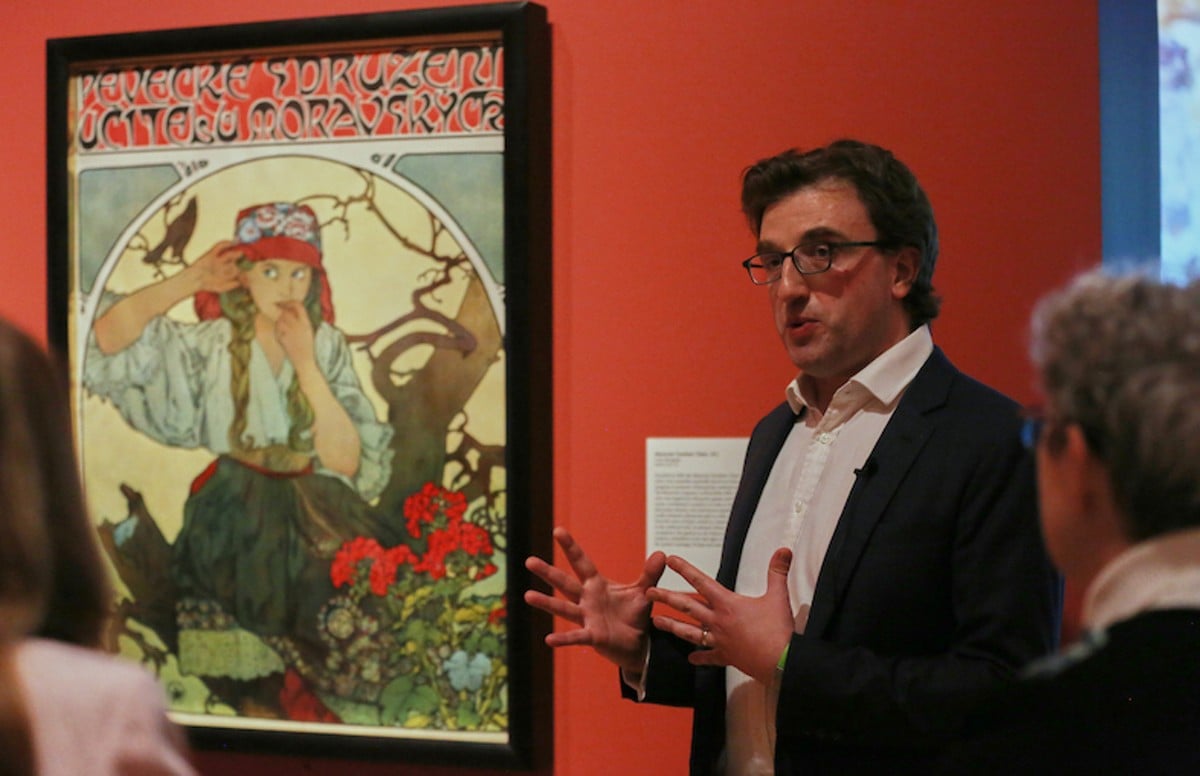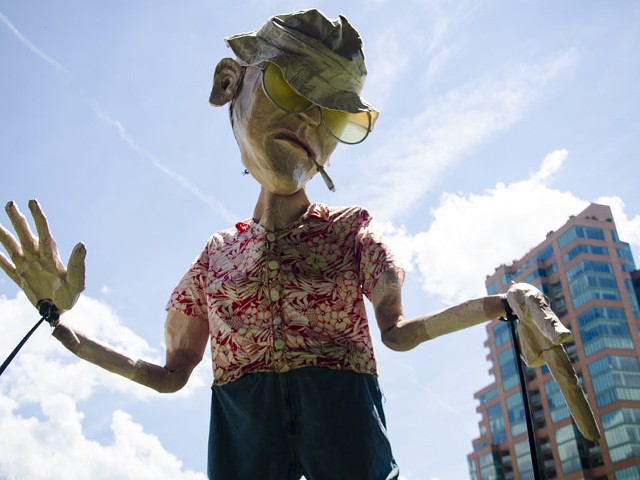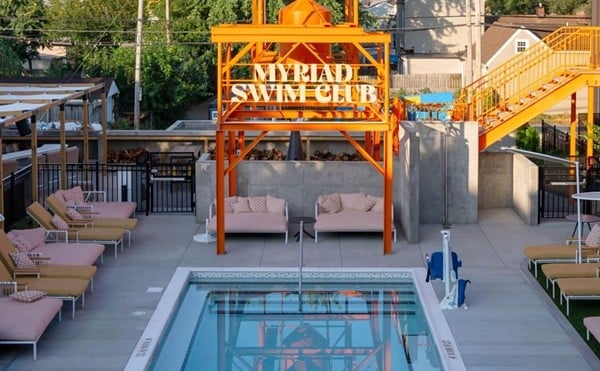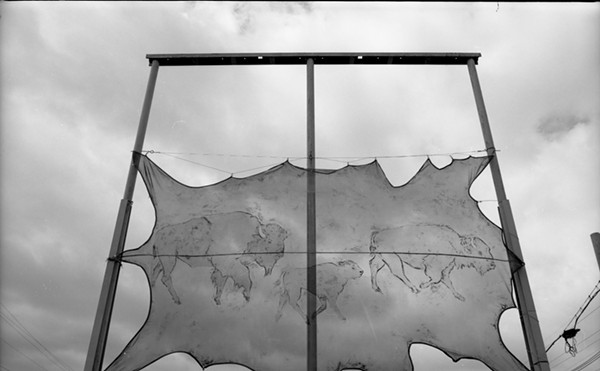Alphonse Mucha is perhaps the most famous poster and decorative artist of the Art Nouveau era. He was certainly much more profound and prolific than his famous posters, and what he understood about design, branding and grabbing the attention of viewers, has been studied and dissected many times over by students of art and historians.
The Speed Art Museum is one of two museums in the country to share the “Alphonse Mucha: Art Nouveau Visionary” show. Many of his most famous works are on view there until Jan. 22, 2023.
How did Mucha become one of the most sought after graphic designers of his time? A bit of luck, and a bit of legal and cultural change in France.
“When you see something like this, posters up until this point have been incredibly popular,” said Kim Spence, director of collections and exhibitions and curator of works on paper, as she introduced LEO to the exhibit. “The laws in France changed around 1881. There had been these restrictions that you couldn’t put posters on walls. You couldn’t put advertisements on walls. They changed the laws, and all of a sudden, commercial companies and theater companies… everybody was trying to advertise something. They started hiring really great artists because there was this incredible competition where you had to grab people’s attention.”
Mucha’s compositions were unusual, bold and for sure grabbed attention with his large female figures, framed by Byzantine clothing or textures and surrounded by rich florals.
Alongside period contemporaries like Henri Toulouse-Lautrec, Jules Chére, Eugène Grasset, the American William H. Bradley and the English Aubrey Beardsley, Mucha’s innovations influenced and expanded what was shaping up to become Art Nouveau.
Alphonse Mucha was a painter born in Moravia, an area in what we now know as the Czech Republic, but was living and working in Paris. When actress Sarah Bernhardt wanted a new poster for her play, “Gismonda,” she made a call to Maurice de Brunhoff, the manager of the publishing firm Lemercier. De Brunhoff needed an artist on short notice as none of his usual artists were available. Mucha had seen Bernhardt and even sketched her in 1890 for “Cleopatra” for Costume au Théâtre. De Brunhoff contacted Mucha and asked him to design the new poster. Mucha gave them something unexpected and completely new. At the time, Mucha was living with fellow artist Paul Gauguin and living the late 19th century artist life, and when he shared the idea with De Brunhoff, the response was not what Mucha expected. De Brunhoff hated it, but he had no choice except to turn the idea over to Bernhardt.
“So Alphonse, as he tells the story in his memoir, he kind of walked home through the snow feeling that he’d blown his one shot at success,” said Marcus Mucha, great grandson of the artist. “Imagine — it’s horrible. He got back to his apartment and there was a note on the door saying, ‘Come to the Théâtre de la Renaissance immediately, orders of Madam Sarah.’”
Marcus Mucha and “Alphonse Mucha: Art Nouveau Visionary” curator Tomoko Sato stopped in Louisville for the opening of the show at the Speed this October. During their visit, along with Spence, they discussed many of the works and facets of Mucha’s fascinating life.
One of the innovations of Mucha was the way his posters were composed, often taking two landscape sheets and making a large vertical that made it feel as if the actress were standing on the street next to you. It was visually stunning and became quite a popular collectible amongst people in Paris.
“What would happen is, people would go and bribe the bill stickers to let them take a copy of it home. Or people would go out with a razor blade, cut down the poster and take it away,” says Marcus Mucha.
The Speed took great care in presenting “Alphonse Mucha: Art Nouveau Visionary.” From the coordinating colors and wall textures used in the exhibit to the items of the Art Nouveau era from the Speed’s collection added to the exhibit, the audience is given a dreamy window into the time and feel of the Art Nouveau and the “Belle Époque” of France and Europe during the late 19th century, a time before the world wars that would change Europe forever.
The show shows an artist who, despite living in Paris, kept very close to his Moravian and Byzantine roots. He often added the motifs of his homeland into his compositions.
“He grew up as a member of a discriminated-against Czech-speaking minority in that empire,” said Marcus Mucha. “There were already rumblings of a kind of Czech-Slovak independence movement. And there were ways in which people were trying to encourage the Czech language to come back. It had been banned for a while. There was kind of a Czech nationalist revival trying to get the language to come back. Mucha’s Czech roots were really important to him.”
Throughout his work, even in the works commissioned by Bernhardt, Mucha managed to pull his heritage and roots into the compositions. Another aspect of Mucha’s work was that his compositions almost always featured women as central figures and depicted them as symbols of power and strength. In this way, he offered a feminist tone to his view of the female in contemporary culture.
His work with Bernhardt solidified his fame but he actively worked with other companies and produced cigarette ads like the famous “Job” poster and perfume ads amongst others before beginning to seek fulfillment in his work in other ways.
He, like many artists, felt that industrialization and mechanization had too large a place in the world.
“All of these Art Nouveau artists reacted to it, and they actually wanted to say, ‘Let’s return to nature.’ And Mucha completely agreed with that. That is his aesthetics, and also it is his ethos,” said show curator Tomoko Sato.
“That’s what you see in the decorative arts pieces from our collection,” said Spence. “In addition to the Otto Eckmann, you see all of these references to nature that are so characteristic of the Art Nouveau. You see it in this wonderful tall glass by Tiffany that takes the form of a tulip.”
One of the fascinating aspects of exploring this show was the connections Mucha had to other artists. Tiffany and Mucha actually knew each other.
“One bonus here is Mucha was friendly with Tiffany,” said Sato. “They met in Paris, and when Mucha came to America, he revisited Tiffany’s workshop, and there was a record, actually; Mucha might have been commissioned [for] some design.”
In 1900, Mucha was at the height of his influence, wealth and power as an artist but he was largely unhappy. His unhappiness stemmed from the knowledge that as Paris was gearing up for a World’s Exposition where he was commissioned to paint murals for the Bosnia-Herzegovina pavilion, he learned about the oppression of Slavic people in these regions. Instead of making a political statement, however, he used this assignment to celebrate the heritage and cultural diversity of the region. Then, because he was unsatisfied with this representing the full picture of Slavic peoples, he began his 20-panel work, the “Slav Epic.”
These paintings are so large that they are unable to travel with the exhibit but they are included in a large video near the end of the exhibit walkthrough.
There is much more to say about this exhibit, but it’s probably best to end with the fact that it is not to be missed. Mucha’s work is much more than decorative and much more than beautiful.
Mucha left Paris near the end of his life. He wanted to be in his homeland, helping his people seek independence. He died of pneumonia, caught during an arrest by the Nazis. Mucha’s son, Ji?í, had fled the area because he was Jewish. When Mucha died, his family had to ask the Nazis to allow a funeral for the artist, as he was a national hero.
“My family, they petitioned the Nazis to be able to have a funeral and to inter him at the national monument. The Nazis said yes, but only the immediate family could attend,” Marcus Mucha said.
“We think that the idea was that my grandfather would come back and then they would seize him. So my grandfather did come back, but rather than listening to the Nazis, over 100,000 regular Czech people came up and lined the streets of Prague to the National Monument to bid farewell to their national artist. And, that was one of the last big public acts of protest before the dark years of the Nazi occupation.” •
See “Alphonse Mucha: Art Nouveau Visionary” at the Speed Art Museum now through Jan. 23.
Keep Louisville interesting and support LEO Weekly by subscribing to our newsletter here. In return, you’ll receive news with an edge and the latest on where to eat, drink and hang out in Derby City.
Follow us on Facebook, Twitter and Instagram.







